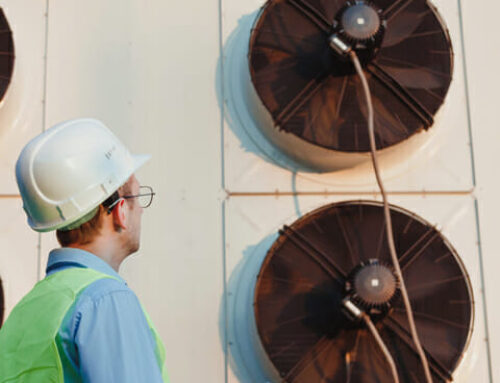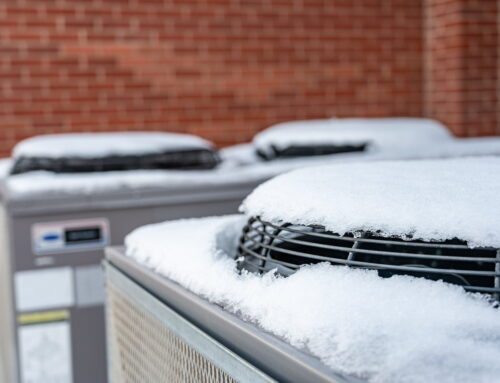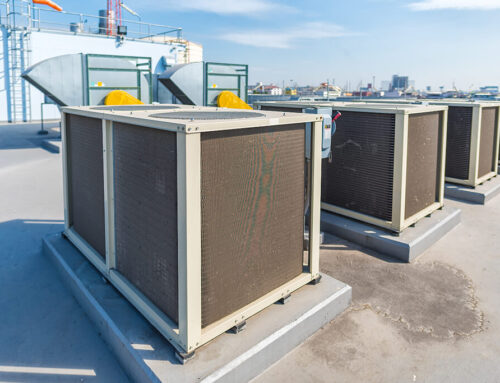Upgrading your commercial HVAC system with efficient heat pumps and air conditioners isn’t just about staying cool or warm; it’s a strategic move that can slash energy bills, resulting in cost savings, and boost performance. With technology advancing rapidly, yesterday’s models of efficiency equipment and HVAC systems are today’s dinosaurs, guzzling more energy than needed, while modern heat pumps operated by skilled technicians offer far greater efficiency. Modern systems, including commercial HVAC upgrades, whisper quietly in the background while keeping operational costs down through improved efficiency equipment and automation, and maintaining comfort up with reduced energy consumption. They’re smart, too—anticipating needs before you even voice them. If your facility’s system has been around since dial-up internet was a thing, it might be time to consider commercial HVAC upgrades with better ratings.
Navigating the maze of options for commercial HVAC system upgrades, with a focus on cost savings, energy consumption, and improved ratings, doesn’t have to be daunting. The right choice of a new HVAC system with higher ratings can mean cleaner air, better control over indoor climate in commercial buildings, and savings that make finance departments smile.
Benefits of Upgrading Your Commercial HVAC System
Air Quality
Upgrading your commercial HVAC system can significantly improve indoor air quality and lead to cost savings with a higher SEER rating. Newer commercial HVAC systems are designed with advanced filtration features that capture pollutants and allergens, offering cost savings through higher SEER ratings. This means cleaner air for everyone inside the building.
Improved air quality from commercial HVAC upgrades with higher SEER ratings leads to fewer health issues among occupants and cost savings. It reduces problems like headaches, allergies, and respiratory issues. Employees in buildings with high-quality air, often due to advanced HVAC systems with high SEER ratings, report feeling better overall.
Energy Savings
Modern HVAC systems, with higher SEER ratings, are more energy-efficient than older models, leading to cost savings. By upgrading, businesses see a drop in energy use. Less energy used, especially from higher SEER HVAC systems, translates directly into lower utility bills and cost savings each month.
These savings add up over time and can offset the cost of the new high SEER HVAC system. Moreover, efficient HVAC systems often qualify for tax incentives or rebates which further reduce expenses.
Property Value
An upgraded HVAC system can increase your property’s value and marketability. A building with a modern, efficient HVAC system is attractive to potential buyers or tenants.
Owners find it easier to lease spaces when they have reliable and effective HVAC climate control systems installed.
-
Tenants prefer buildings with efficient HVAC systems that offer comfort without high utility costs.
-
Buyers look for properties with reliable HVAC systems that won’t require immediate upgrades or repairs.
Understanding Energy-Efficient HVAC Systems
Efficiency Ratings
Efficiency is key when upgrading HVAC systems. SEER, EER, and IEER ratings measure this efficiency. A higher SEER (Seasonal Energy Efficiency Ratio) means better HVAC performance in residential environments, while EER (Energy Efficiency Ratio) applies to commercial settings. IEER (Integrated Energy Efficiency Ratio) offers a more comprehensive look at HVAC systems by considering part-load performance.
HVAC systems with high ratings use less energy for the same cooling effect. This slashes electric bills and reduces strain on resources. For example, a heat pump with an impressive SEER rating will cool effectively without hiking up HVAC costs.
ENERGY STAR
ENERGY STAR certification marks top performers in energy efficiency. Look for this label when choosing new equipment. It signals that the HVAC unit meets strict criteria set by the EPA.
An ENERGY STAR-certified HVAC system could save significantly on energy consumption compared to older models or units without certification. Such HVAC upgrades not only cut costs but also support environmental sustainability.
Advanced Features
Modern HVAC features like variable speed fans make a big impact too. These HVAC fans adjust their speed based on need, leading to smarter energy use and improved comfort levels within buildings.
With advanced technology, these HVAC systems provide consistent temperature control and quieter operation—a stark contrast to older models that run at full blast or not at all. Upgrading your commercial HVAC system can mean embracing such innovations for long-term benefits both financially and environmentally.
Financial Incentives and Cost Savings
Tax Benefits
Upgrading to an energy-efficient commercial HVAC system can lead to financial benefits. Business owners may be eligible for tax credits or rebates for HVAC systems. These incentives are designed to reduce the initial cost of purchasing new HVAC equipment.
Businesses often save money due to these programs. For example, a tax credit might cover 30% of the cost of HVAC installation. This makes upgrading more affordable and appealing.
Long-Term Savings
The long-term cost savings from newer HVAC systems come in several forms. First, they typically require less maintenance than older units. This means lower ongoing maintenance costs.
Over time, businesses notice a decrease in their energy bills due to efficient HVAC systems too. Newer systems operate more efficiently, using less power to heat or cool the same space compared with outdated models.
Payback Period
Understanding the payback period is crucial for business owners considering upgrades. It’s calculated by dividing the upgrade cost by annual savings on energy bills.
If an upgrade costs $10,000 and saves $2,500 annually on energy bills, the payback period would be four years. After this period passes, all additional savings go directly into business profits making it a wise investment for many companies.
Planning and Considerations for HVAC Upgrades
System Assessment
Before considering HVAC upgrades, it’s essential to assess your current system. Check how well it performs. Does it meet the needs of your space? An expert can measure its efficiency and capacity.
Upgrading may be necessary if your system is old or underperforming. A new, efficient unit could save money in the long run. It might also improve comfort within the building.
Climate Factors
The climate plays a big role in selecting an HVAC system. Different climates need different systems. For example, a humid area might need better moisture control.
Pick a system designed for your local weather conditions. This ensures comfort all year round and avoids unnecessary strain on the equipment.
Integration Needs
Many buildings have automation systems already in place. Your new commercial HVAC should work with these systems smoothly.
Integration allows for easier management of heating and cooling settings from one central point. It can also help track energy usage more accurately, which ties back to cost savings discussed earlier.
Choosing the Right Commercial HVAC Contractor
Experience Check
After planning your commercial HVAC system upgrades, it’s crucial to pick a qualified contractor. Look for those with ample experience in commercial buildings. Verify their certifications too.
A seasoned contractor will have a proven track record. They should show you past projects similar to yours. Ask for references and check them out.
Quote Clarity
Getting clear quotes is vital before work begins. A detailed quote helps avoid hidden costs later on.
Request itemized quotes from multiple contractors. Compare them carefully. Ensure they include labor, materials, and any additional fees.
Support Assurance
Post-installation support is as important as the installation itself. You want someone who’ll stand by their work after completion.
Contractors must offer solid warranties and support services. This shows they are confident in their quality of service.
Innovative Technologies in Commercial HVAC
Smart Thermostats
Smart thermostats have become a game-changer for commercial HVAC systems. These devices allow precise control over indoor temperatures. Businesses save on energy costs by programming ideal temperature settings for different times of the day.
They also adapt to usage patterns, improving comfort while reducing waste. For instance, a smart thermostat can lower heating when an office is empty after hours.
IoT Integration
The Internet of Things (IoT) is revolutionizing commercial HVAC management. IoT devices enable real-time monitoring and adjustments from anywhere. This means maintenance teams can address issues promptly without being on-site.
Real-time data collected helps predict system needs and schedule maintenance efficiently, preventing unexpected breakdowns which could disrupt business operations.
Air Purification Advances
Advancements in air purification are vital for maintaining good indoor air quality. Modern commercial buildings now often include state-of-the-art filtration systems that capture pollutants and pathogens effectively.
These technologies not only keep the air clean but also help protect the health of everyone inside the building. They are especially important in industries where clean air is crucial, such as healthcare or manufacturing with strict cleanliness standards.
Maintaining and Servicing Your Upgraded HVAC System
Professional Inspections
Regular checks are key. Professionals should inspect your HVAC system often. This ensures it runs well. They spot small issues before they grow.
Technicians use advanced tools. They assess the air quality and efficiency of your new system. Regular maintenance keeps the unit in top shape.
Preventative Plans
A good plan avoids future problems. It extends the life of your HVAC equipment significantly.
Facility managers can create a schedule for upkeep tasks like filter changes or duct cleaning, which helps to prevent breakdowns and maintain consistent heating and cooling performance throughout the building.
Staff Training
Knowing basic care is important for staff members too; this allows them to handle minor issues without always needing a technician’s help, saving time and resources in the long run.
Training includes how to operate advanced controls or automation systems that come with an upgraded commercial HVAC setup, ensuring optimal use and familiarity with updated features that improve overall functionality.
Measuring the Impact of HVAC Upgrades on Business Performance
Energy Savings
After upgrading a commercial HVAC system, it’s crucial to track changes in energy bills. Look at your bills before and after the upgrade. You’ll likely notice a decrease in costs due to improved EER ratings.
Upgraded systems often use less power for the same amount of cooling or heating. This is especially true for larger spaces, where savings per square foot can be significant.
Comfort Level
Employee comfort can affect productivity. After an HVAC upgrade, monitor how staff feel about their work environment.
Are they less distracted by temperature issues? Do they report feeling better overall? These signs suggest that the new system is making a positive difference.
Customer Satisfaction
Customers’ impressions of your indoor environment are also important. If you run a store or office space, ask for feedback on the comfort levels post-upgrade.
Happy customers tend to stay longer and return more often, which can boost sales and reputation.
Closing Thoughts
Upgrading your commercial HVAC system is more than a one-time improvement; it’s an investment in your business’s future. You’ve seen the benefits, from energy efficiency to financial savings, and how the right technology can streamline operations. Now, imagine your workplace transformed—cooler, greener, and cost-effective. It’s not just about comfort; it’s about setting a standard for your industry and showing that you’re ahead of the curve.
Ready to take the leap? Reach out to a trusted HVAC contractor and start the conversation. Your business deserves the best, and with the right upgrades, you’ll feel the difference, in both the air and your bottom line. Don’t let another season pass by—make your move towards a smarter, more sustainable workspace today.






